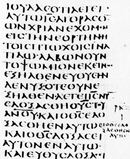mgen
JF-Expert Member
- Nov 18, 2010
- 22,631
- 8,417
Umesha jibiwa kwamba BIBLIA YA UKWELI HALISI NI BIBLIA! Shahidi Mungu wako allah! Au naye humuamini?!Mgen , UMEKUWA SIKIO LA KUFA , UNATAFUTA TUKUJIBU LAKINI HATUKUJIBU
SISOI TUKO KWENYE MADA YA THREAD,
Je Biblia ya ukweli/Halisi ni ipi?
Director's Cut
"The evangelists were inventors – not historians." – Porphyry, Against the Christians, c. 280 AD.
It was well into the 2nd century before a number of these ‘testimonies’ were collected together and bound into a single volume. From the mass of available material ecclesiastical editors selected what would and what would not be included in the Good Book. But of course different editors made different choices.
Search the Bible in vain for the gospels of Thomas, Matthaias or the ‘The Twelve’; for the Acts of Andrew or Acts of John; for the Epistle of Barnabas, the Didache; for the Shepherd of Hermas or the Apocalypse of Peter. Yet for the first two centuries of Christianity all of these were holy scripture, the revealed Word of God.
On the other hand rejected by the early church fathers were Paul’s letter to Philemon, the second and third letters of John, the second letter of Peter and the General Epistle of Jude, all part of the canon after Christianity became the state religion!
Clearly the Big Guy had had a major rethink. Roman bibles after the fourth century hedged their bets and included ‘doubtful’ and previously rejected material at the end as ‘Apocrypha’ (‘hidden’). Clearly this was God’s rough draft, not really meant for publication. Luther kept the apocrypha in his bible whereas Calvin and most other Protestant reformers excluded them.
To regard this wholesale editorial selection and censorship, and the rewriting which accompanied it, as a function purely of the human mind, influenced by considerations of ambition and wealth, power and politics, is, of course, to lose sight of the hand of god; the divine, beavering away in overdrive in central Europe and the eastern Mediterranean centuries ago!
Sent using Jamii Forums mobile app
